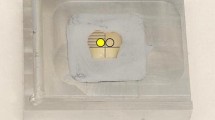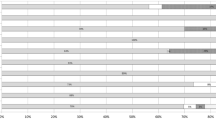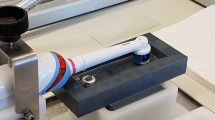Abstract
Objectives
The use of dental sealants has been extended to smooth enamel surfaces. The present study was conducted to test the in vitro performance of four sealants with different characteristics (highly and lowly filled, self-etching features).
Materials and methods
Eighty human teeth (lower incisors and premolars) were randomly divided into following sealant test groups: ProSealTM, LightBondTM, OrthoSoloTM, and Seal&Protect®. Twenty untreated teeth served as a control group. Tooth brushing was conducted for a period of time simulating 12, 18, and 24 months. During the toothbrush abrasion protocol, the specimens were subjected to thermal and acidic challenge. Sealant thickness was determined with μCT imaging, and qualitative and quantitative surface effects were investigated using stereo microscopy and raster electron microscopy, respectively. Data were subjected to t test or Kruskal–Wallis/Mann–Whitney tests (alpha, 5 %).
Results
The wear behavior and film integrity of highly filled sealants were superior to lowly filled sealants. Even after 1 year of tooth brushing, significant surface deterioration with deleterious loss of enamel and discoloration was observed in all tested materials (χ2 = 15.349; P = 0.004). The size of the observed defects increased over time.
Conclusion
These results suggest that the application of sealants on smooth enamel surfaces should be limited to special indications, and their usefulness has to be revisited.
Clinical relevance
Based on the results of this in vitro study, the general overall application of enamel sealants needs to be questioned.





Similar content being viewed by others
References
Bishara SE, Oonsombat C, Soliman MM, Warren J (2005) Effects of using a new protective sealant on the bond strength of orthodontic brackets. Angle Orthod 75:239–242
Schmidlin PR, Zehnder M, Zimmermann MA, Zimmermann J, Roos M, Roulet JF (2005) Sealing smooth enamel surfaces with a newly devised adhesive patch: a radiochemical in vitro analysis. Dent Mater 21:545–550
Schmidlin PR, Göhring TN, Sener N, Lutz F (2002) Resistance of an enamel-bonding agent to saliva and acid exposure in vitro assessed by liquid scintillation. Dent Mater 18:343–350
Banks PA, Richmond S (1994) Enamel sealants: a clinical evaluation of their value during fixed appliance therapy. Eur J Orthod 16:19–25
Ceen RF, Gwinnett AJ (1980) Microscopic evaluation of the thickness of sealants used in orthodontic bonding. Am J Orthod 78:623–629
Fornell AC, Sköld-Larsson K, Hallgren A, Bergstrand F, Twetman S (2002) Effect of a hydrophobic tooth coating on gingival health, mutans streptococci, and enamel demineralization in adolescents with fixed orthodontic appliances. Acta Odontol Scand 60:37–41
Frazier MC, Southard TE, Doster PM (1996) Prevention of enamel demineralization during orthodontic treatment: an in vitro study using pit and fissure sealants. Am J Orthod Dentofacial Orthop 110:459–465
Kersten S, Lutz F, Schupbach P (2001) Fissure sealing: optimization of sealant penetration and sealing properties. Am J Dent 14:127–131
Lussi A, Jaeggi T, Gerber C, Megert (2004) Effect of amine/sodium fluoride rinsing on toothbrush abrasion of softened enamel in situ. Caries Res 38:567–571
Turssi CP, Ferracane JL, Vogel K (2005) Filler features and their effects on wear and degree of conversion of particulate dental resin composites. Biomaterials 26:4932–4937
Wicht MJ, Haak R, Lummert D, Noack M (2003) Treatment of root caries lesions with chlorhexidine-containing varnishes and dentin sealants. Am J Dent 16:25A–30A
Momoi Y, Hirosaki K, Kohno A, McCabe JF (1997) In vitro toothbrush-dentifrice abrasion of resin-modified glass ionomers. Dent Mater 13:82–88
Sakaguchi RI, Douglas WH, Delong R, Pintado MR (1986) The wear of a posterior composite in an artificial mouth: a clinical correlation. Dent Mater 2:235–240
Speranza G, Gottardi G, Pederzolli C, Lunelli L, Canteri R, Paquardini L et al (2004) Role of chemical interactions in material adhesion to polymer surfaces. Biomaterials 24:2029–2037
Schmidlin PR, Goehring TN, Roos M, Zehnder M (2006) Wear resistance and surface roughness of a newly devised adhesive patch for sealing smooth enamel surface. Oper Dent 31:115–121
Boyd RL, McLey L, Zahradnik R (1997) Clinical and laboratory evaluation of powered electric toothbrushes: in vivo determination of average force for use of manual and powered toothbrushes. J Clin Dent 8:72–75
Reynolds IR (1976) A review of direct orthodontic bonding. Brit J Orthod 2:171–178
Zachrisson BU (1977) A post treatment evaluation of direct bonding in orthodontics. Am J Orthod 71:173–189
Newman GV (1978) A post treatment survey of direct bonding of metal brackets. Am J Orthod 74:323–331
Zachrisson BU, Heimgard E, Ruyter IE, Mjoer IA (1979) Problems with sealants for bracket bonding. Am J Orthod 75:641–649
Wang WN, Tarng TH (1991) Evaluation of the sealant in orthodontic bonding. Am J Orthod Dentofacial Orthop 100:209–211
Warren PR, Cugini M, Marks P, King DW (2001) Safety, efficacy and acceptability of a new power toothbrush: a 3-month comparative clinical investigation. Am J Dent 14:3–7
Steffen JM (1996) The effects of soft drinks on etched and sealed enamel. Angle Orthod 66:449–456
Van Eygen I, Vannet BV, Wehrbein H (2005) Influence of a soft drink with low pH on enamel surfaces: an in vitro study. Am J Orthod Dentofacial Orthop 128:372–377
Barclay CW, Spence D, Laird WR (2005) Intra-oral temperatures during function. J Oral Rehabil 32:886–894
Pazinatto FB, Campos BB, Costa LC, Atta MT (2003) Effect of the number of thermocycles on micro leakage of resin composite restorations. Pesqui Odontol Bras 17:337–341
Azzopardi A, Bartlett DW, Watson TF, Sherriff M (2004) The surface effects of erosion and abrasion on dentine with and without a protective layer. Br Dent J 196:351–354
Attin T, Buchalla W, Trett A, Hellwig E (1998) Tooth brushing abrasion of polyacid-modified composites in neutral and acidic buffer solutions. J Prosthet Dent 80:148–150
Conflict of interest
The authors declare that they have no conflict of interest.
Author information
Authors and Affiliations
Corresponding author
Rights and permissions
About this article
Cite this article
Korbmacher-Steiner, H.M., Schilling, A.F., Huck, L.G. et al. Laboratory evaluation of toothbrush/toothpaste abrasion resistance after smooth enamel surface sealing. Clin Oral Invest 17, 765–774 (2013). https://doi.org/10.1007/s00784-012-0771-8
Received:
Accepted:
Published:
Issue Date:
DOI: https://doi.org/10.1007/s00784-012-0771-8




